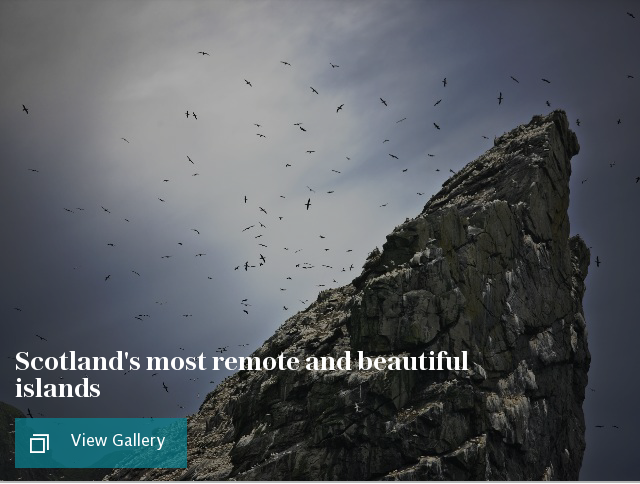Porridge and prayer flags – introducing the tiny Scottish isle that became a Buddhist retreat

By the time I arrive at Holy Isle, I already feel a world away from hectic modern life. The air is fresh and clean; an oystercatcher forages along the shore where the scraggy hills meet the crystal blue sea.
It has taken 24 hours to get here, starting with seven-and-a-half blissful hours on the train up to Glasgow, decompressing, reading my book and watching the scenery whizz by. After an overnight city pitstop, it’s another hour on the train to Ardrossan on Scotland’s west coast, a ferry to Arran and a short bus ride to Lamlash pier.
I spot a few women carrying yoga mats heading my way and by the time we board the tiny boat to Holy Isle together, I realise that many of us really are in the same boat as first-time visitors to this gem of an island. We arrive full of expectation and apprehension and walk up from the pontoon past the colourful, billowing Tibetan prayer flags. There’s zero chance of phone reception or Wi-Fi and that’s partly why I came.
With a spiritual heritage that dates back to the sixth century, Holy Isle has been a dedicated Centre for World Peace and Health since 1992, owned by the Samye Ling Buddhist community. I’m here for a three-day meditation, massage and yoga retreat for women - a chance to slow down, switch off and reconnect to myself and to these beautiful natural surroundings.
After dinner cooked by the volunteers who run the centre, 20 of us head into the Peace Hall for an introduction session with our teacher Ratnadevi, a Glasgow-based mindfulness and yoga teacher. We introduce ourselves, ease into gentle movements and enjoy our first group meditation before bedtime. While some guests have booked into dorms, I’m glad of my single room where silence continues.

At 7.30am, the day begins with tai chi to wake up the body’s energy. After a hearty (and traditional Scottish) porridge breakfast, we slip into the day’s routine. Guided meditation is followed by gentle yoga and we pair up for (fully-clothed) massage sessions, learning how to sense and ease tension in each other’s necks, backs and arms.
The afternoon is ours. I pop on my walking boots to explore the two-mile island. Rare Soay sheep, Eriskay ponies and Saanan goats roam near the beach. It’s a fairly level track, with various Buddhist shrines and rock paintings along the way. As the path turns inland, I pass the cordoned-off long-term Buddhist retreat in the converted lighthouse cottages at the island’s south end.
Suddenly it’s wet, windy and wild and I get drenched but head on to Pillar Rock Lighthouse to watch the waves crashing. On my return, I pass a small sign and follow the steps up to the hermit cave of the sixth century Christian monk, St Molaise – sat perched on a small rock, I look out at the majestic view towards Arran.
Just as Tibetan yogis sought solitude in the Himalayas, Celtic Christians were drawn to Holy Isle for space to pray and meditate. This view hasn’t changed in all those years, except for one telegraph cable. Holy Isle may not be exotic or far-flung but the solitude and the beauty is authentic and it’s a relief to know that this special place exists so close to home.
Invigorated, I take my cup of herbal tea and slowly wander around the pretty ‘mandala gardens’ where ornaments and Buddhist sayings adorn the flower beds, but going for a gentle stroll north along the beach.

Lamlash Bay, between Holy Isle and Arran, is Scotland’s first No Take Zone, where all methods of fishing and harmful activities are banned. The rich marine life is evident as I beachcomb. I spot a blue lobster shell, pink crab claws, sea urchin shells, a seabird skull and dolphin vertebrae. But this sacred place isn’t protected from ocean pollution and as I return with my bag of plastic finds, the Arran lifeboat passes by – perhaps Holy Isle isn’t that isolated after all.
On the final evening, Ratnadevi leads us through a workshop about our ‘inner critic’. Before leaving the next morning, I reflect on the past three days in this sacred space. I feel more peaceful and creative (I even wrote a poem) and I have savoured the lack of incoming information – no emails, no social media, no deadlines. But as lovely as the other guests were, I realise I may prefer the depth and intensity of a totally silent retreat.
As the ferry leaves Holy Isle pontoon, a seal pops its head up, as if to say goodbye. I just hope I can hold on to the sense of stillness I have found here, just a short trip from the Scottish mainland. Once I get back to Glasgow train station, I notice I’m walking more slowly, happy to let the hustle and bustle of commuters flow past me.
Long may that last.


